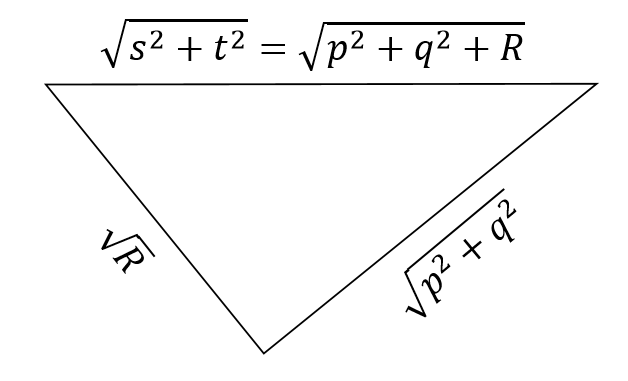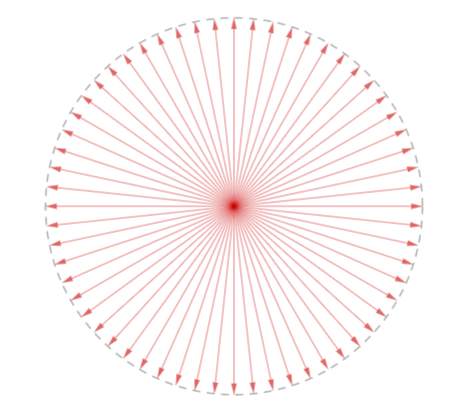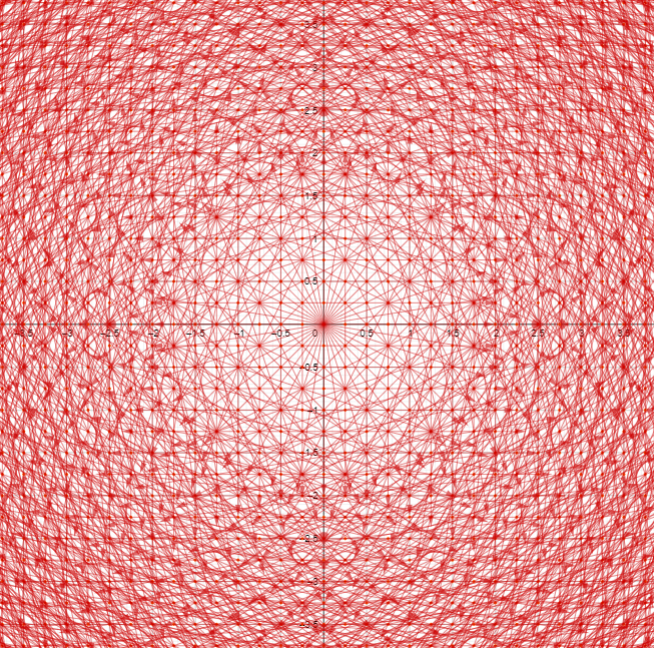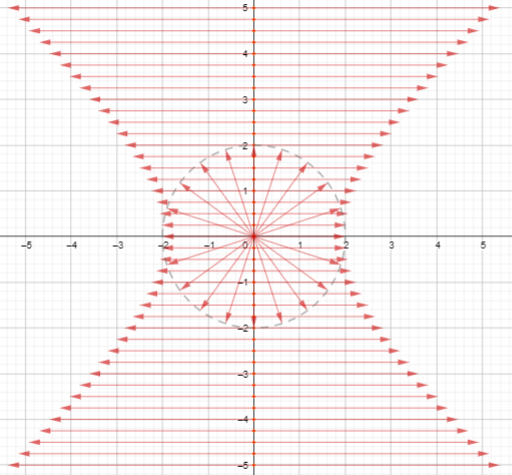Introduction
This is the last (for now) post in a series about about i-arrows, which are a way I have created of visualising the complex points on graphs in the real plane. As I’ve done for every other post since the first one, I will repeat the description here.
Every point with complex coordinates is represented as an arrow (which I call an “i-arrow”) from one place to another on top of the Cartesian plane.
- Real points are dots on the Cartesian plane, the same as they have always been.
- The complex point (p+si,q+ti) is represented as an i-arrow, which is an arrow based at the point (p,q) and extends along the vector (s,t) to have its arrowhead at the point (p+s,q+t).
In the picture below, there are three examples of i-arrows.
- The complex point (1+4i,2+i) has been drawn as an i-arrow. Its base is at the point (1,2) and its arrowhead is at the point (1+4,2+1)=(5,2).
- The complex point (7,2i) has been drawn as an i-arrow. Its base is at the point (7,0) and its arrowhead is at the point (7,0+2)=(7,2).
- The complex point (12-2i,3) has been drawn as an i-arrow. Its base is at the point (12,3) and its arrowhead is at the point (12-2,3)=(10,3).
In the previous blog post, I talked about the complex points on a real circle, with an equation like (x-g)²+(y-h)²=R for a positive number R. In this blog post, I’ll talk about the complex points on an unreal circle.
Circles with negative area
The equation x²+y² = R for positive number R represents a circle in the sense that the collection of points (x,y) with real coordinates that satisfy the equation are indeed a circle. The area of that circle will be πR and its radius is √R.
The equation x²+y² = -R for positive number R represents nothing at all. There are no real numbers x and y that satisfy this equation, because when you square real numbers, you can’t get a negative result. And that’s that.
Except it’s not. That first equation equation x²+y² = R has a large number of points (x,y) with complex coordinates that satisfy it, and when you draw those points as i-arrows, they have a beautiful and surprisingly simple structure. There are definitely going to be points with complex coordinates that satisfy x²+y² = -R, and it would be completely unsurprising if they also had a beautiful and simple structure.
If the circle with equation x²+y² = R has area πR and radius is √R, then it seems fair to say that the area of the circle with equation x²+y² = -R is -πR and its radius is √(-R) = √R i. So I am going to say that this circle has negative area and imaginary radius.
Ever since I found a way of thinking about where complex points are, I’ve wanted to investigate what circles with negative area look like. Now I finally can do it properly, with i-arrows.
Complex points on a circle with negative area: the i-arrows at each point
Just like I did for real circles, I’ll start by substituting in a general complex point and see what happens.
Consider the equation of a circle with negative area, x²+y² = -R, for positive real number R. Let (p+si,q+ti) be a complex point, for real numbers, p, q, s, t, and suppose (p+si,q+ti) satisfies the equation x²+y² = -R.
(p+si)²+(q+ti)² = -R
p² + 2psi – s² + q² + 2qti – t² = -R
p² + q² – s² – t² + (2ps+2qt)i = -R
Equate real and imaginary parts.
Imaginary:
2ps + 2qt = 0
ps + qt = 0
(p,q) • (s,t) =0
This tells me that the vector (s,t) is perpendicular to the vector (p,q), which goes from the origin to the point (p,q). This is the same as what happened for a real circle.
Real:
p² + q² – s² – t² = -R
p² + q² +R = s² + t²
s² + t² = p² + q² + R
√(s² + t²) = √(p² + q² + R)
||(s,t)|| = √(p² + q² + R)
Again this is almost the same as what happened for a real circle. I have the possible directions from the imaginary part, and a formula for the length from the real part, which is enough to locate the i-arrow. But the geometrical interpretation is just a little different.
It is still true that √(p² + q²) is the length of the journey from the origin to (p,q) and that this length, √R and ||(s,t)|| are related by a Pythagoras-theorem-like expression. But this time, the different parts are playing different roles. Now, ||(s,t)|| is the hypotenuse of the triangle, and √R and √(p² + q²) are the short sides.
Last time, the right-angle told me there was a tangent to the circle, but this time that’s not going to happen. That right angle has to be at the origin, which is the centre of the circle, so it’s just not going to work. So my hope for a nice geometrical construction fades. After playing around, this is the best I can do.
To find the complex points on the circle of negative area x²+y² = -R whose i-arrows are based at P=(p,q):
- Draw the line from the origin to P.
- Draw a circle of radius √R centred at the origin.
- Draw a diameter of this circle perpendicular to the line from the origin to P and mark where it meets the circle.
- Draw a circle centred at P passing through the two points on that diameter just marked.
- Draw a line through P perpendicular to the line from the origin to P and mark where it meets the circle just drawn.
- The two points just marked are the arrowheads of the i-arrows based at P.
Actually a fairly simple construction now I’ve seen the picture! I note that the construction will work no matter whether P is inside, outside or on the edge of that dotted-line circle of radius √R, so for any point P there will always be complex points whose i-arrows are based there.
This bears out in the algebra, since (p² + q² + R) is always going to be greater than zero — in fact it will always be greater than or equal to R — there will always be a result for √(p² + q² + R) and so always a solution for the length of (s,t).
There is one special case I notice though: when (p,q) is the origin. In that case the length of (s,t) will still have an answer, which will be √R. But also (p,q) • (s,t) =0 for every possible vector (s,t). So actually every vector based at the origin of length √R is an i-arrow on this circle! That is, given any point P, there are two i-arrows on the unreal circle based there, unless P is the origin, in which case there are infinitely many i-arrows on the unreal circle based there, and their arrowheads form a circle of radius √R. I think this is so cool! The imaginary circle really does contain an imaginary circle in its complex points.
I guess the last thing to do is to calculate the coordinates of the arrowheads for the i-arrows at a specific point (p,q). This ought to be very similar to what happened for a real circle.
The vector (s,t) is perpendicular to the vector (p,q), so it’s some multiple of (q,-p).
Let’s say (s,t)=m(q,-p).
The length of (s,t) now has two ways to figure it out.
||(s,t)|| = ||m(q,-p)||
= |m| ||(q,-p)||
= |m| √(p² + q²)
and
||(s,t)|| = √(p² + q² + R)
So
|m| √(p² + q²) = √(p² + q² + R)
|m| = √(p² + q² + R) / √(p² + q²)
= √[1 + R/(p² + q²)]
Therefore
(s,t) = ±√[1 + R/(p² + q²)] (q,-p)
And so the arrowheads of the i-arrows based at (p,q) are at
(p+q√[1 + R/(p² + q²)], q-p√[1 + R/(p² + q²)])
and
(p-q√[1 + R/(p² + q²)], q+p√[1 + R/(p² + q²)]).
Yes, this is exactly the same as what happened for a real circle. Indeed, if I have the equation x² + y²=R and allow the number R to be negative, I get this for the locations of the arrowheads of the i-arrows based at (p,q) either way:
(p+q√[1 – R/(p² + q²)], q-p√[1 – R/(p² + q²)])
and
(p-q√[1 – R/(p² + q²)], q+p√[1 – R/(p² + q²)]).
How nice. What this means is it’s actually very easy to set up a GeoGebra activity that covers both real and unreal circles. This is precisely why I have been doing the equations as x² + y²=R as opposed to x² + y²=r², by the way. So that I could smoothly transition from real to unreal without a major change in the algebra. Well I hoped it would turn out that way, and I’m glad it did.
Collections of complex points on an unreal circle
And now I really can investigate the complex points on an unreal circle properly and look at collections of them all at once.
All the i-arrows at once
First, all the i-arrows for the complex points on the circle x²+y² = -4 of negative area based at the points on a grid with spacing 1/4. (You can play around with this for different values of R, including both positive and negative, as well as different grid spacings, using this GeoGebra activity.
As you can see, there are a lot more lines and arrowheads than there were for the real circle of the matching real radius, due to there being i-arrows based at every point, rather than only ones outside a circle. I think I can at see a space in the middle there that is less red. When I look closer it’s not just that there are fewer arrows there, but specifically fewer arrowheads. But there are almost too many arrows for me to see clearly. Let me try again with a wider grid spacing. This picture is the same but with a grid spacing of 1/2.
I can more easily distinguish that circle of i-arrows at the origin from the rest of the i-arrows, and it’s making me even more sure that there are no arrowheads inside that circle. Let me see if I can confirm that…
The arrowheads of the i-arrows based at the non-origin point (p,q) are given by
(p+q√[1 + R/(p² + q²)], q-p√[1 + R/(p² + q²)])
and
(p-q√[1 + R/(p² + q²)], q+p√[1 + R/(p² + q²)]).
Phew that’s complicated. What if I let m = √[1 + R/(p² + q²)] so that the arrowheads are at
(p+qm,q-pm) and (p-qm,q+pm).
These points will be outside the circle of radius R when their x and y coordinates satisfy x²+y²>R. Let me see what I get for that calculation for the first point.
x²+y²
= (p+qm)²+(q-pm)²
= p² + 2pqm + q²m² + q² – 2qpm + p²m²
= p² + q² + p²m² + q²m²
= p² + q² + (p² + q²)m²
= (p²+q²)(1+m²)
Note the same result would have happened if I had used the other point, because the -2pqm and +2qpm would have appeared in the other order but still had a sum of zero.
Now m = √[1 + R/(p² + q²)]
So m² = 1 + R/(p² + q²).
Therefore
x²+y²
= (p²+q²)(1+m²)
= (p²+q²)(1+1 + R/(p² + q²))
= (p²+q²)(2 + R/(p² + q²))
= 2(p²+q²)+R,
which is definitely greater than or equal to R.
I also notice that if this was a real circle with radius √R, then the arrowhead’s coordinates substituted into x²+y² would have produced 2(p²+q²)-R, which is also greater than or equal to R, since the only points with i-arrows are outside the circle where p²+q²>R. Very nice.
So for an unreal circle with equation x²+y² = -R (for positive R), the i-arrows for its complex points have arrowheads that are all outside the circle of radius √R, plus the circle of i-arrows at the origin, whose arrowheads are the whole of the circle of radius √R itself.
The i-arrows on a vertical line
You can play around with what the i-arrows based at points along a vertical line look like in this GeoGebra activity. It will allow you to change the value of R to be both positive and negative to compare how both real and unreal circles work.
Here is GIF showing a selection of i-arrows on the unreal circle x²+y² = -4 based at points on a vertical line as the line moves back and forth. (The real circle with equation x²+y² = 4 has been shown for reference.)
GIF showing complex points on the graph of the unreal circle x²+y²= -4. Each frame is the i-arrows based at a selection of points along a vertical line. https://t.co/DTKScqq2AL
(WordPress is being weird about GIFs and this is the easiest way to deal with it) pic.twitter.com/d5Rj253Pnm— David Butler (@DavidKButlerUoA) July 31, 2022
It’s a bit jerky, I’m sorry, but GeoGebra was working hard, and also I moved the slider manually because I wanted it to show the circle of i-arrows at the origin for a moment as I went past. I just love that it’s there at that one moment. Actually, what happens at that moment is pretty cool.
As well as the circle of i-arrows at the origin, the arrowheads for all the i-arrows seem to be forming a hyperbola, like they did for a real circle, but the other way around. That definitely deserves investigating, and it ought to look very similar to how it looked for a real circle.
The vectors that are the i-arrows at the point (p,q) are given by
±√[1 + R/(p² + q²)] (q,-p).
If p=0, these vectors are
±√[1 + R/q²] (q,0)
= ±√[q² + R] (1,0).
This confirms that all the i-arrows based along the y-axis are horizontal.
The arrowheads of the arrowheads of the i-arrows based at the point (p,q) are given by
(p,q)±√[1 + R/(p² + q²)] (q,-p).
If p=0, these points are
(0,q)±√[q² + R] (1,0)
= (±√[q² + R],q).
When you take the x-coordinates and y-coordinates and square them, you get this:
x²=q²+R
y²=q²
x²-y²=R
That is indeed the equation of a hyperbola with turning points at (√R,0) and (-√R,0).
Awesome. I am particularly loving how this unreal circle is highlighting the intimate relationship between a circle and a hyperbola.
The i-arrows on the lines through the origin
This hyperobola of i-arrow arrowheads should appear not just for i-arrows based along the y-axis, but along any line through the origin, which means I can cover all the i-arrows on the unreal circle systematically by looking at the ones attached to a rotating line through the origin. Here is the GeoGebra activity that lets you do this for circles of both positive and negative area. And here is the GIF of the i-arrows for the complex points on the unreal circle x²+y² = -4 based at equally-spaced points along a rotating line.
GIF showing complex points on the graph of the unreal circle x²+y²= -4. Each frame is the i-arrows based at points along a line through the origin of a different slope. https://t.co/DTKScqq2AL
(WordPress is being weird about GIFs and this is the easiest way to deal with it) pic.twitter.com/xkWDyYbbnn— David Butler (@DavidKButlerUoA) July 31, 2022
The i-arrows based at points around a circle
Jim Simons on twitter suggested for a real circle to organise the i-arrows by how far their base is from the centre, and it really is a good idea. Here is the GeoGebra activity that will let you investigate this selection of i-arrows for both real and unreal circles. And here is a GIF showing the i-arrows on the negative unit circle with equation x²+y² = -1, organised by how far their base is from the centre.
GIF showing complex points on the graph of the *negative* unit circle circle x²+y²= -1. Each frame is the i-arrows based at a selection of points around a circle. https://t.co/DTKScqq2AL
(WordPress is being weird about GIFs and this is the easiest way to deal with it) pic.twitter.com/ONf9vbnI8A— David Butler (@DavidKButlerUoA) July 31, 2022
I really love this GIF. I love how the i-arrows are longer and longer the further out from the centre they are based, but also I love how the circle of i-arrows at the origin seems perfectly natural now because that’s where the i-arrows based at points around a very small circle are converging towards.
Conclusion
I am very satisfied to have finally got a handle on what is happening with these circles of negative area. I love how the complex points on both the real and unreal circles have that hyperbola of arrowheads formed by the i-arrows based along a line through the circle’s centre. It’s just so simple and clean. Even more than this, I just love that circle of i-arrows based at the centre of an unreal circle. It’s just so very circley and simultaneously unreal, just like you would hope on an unreal circle. Just to draw all of this together, here is a GIF of the hyperbola of arrowheads for the i-arrows along a rotating line for circles x²+y² = R, with R ranging from -5 to 5.
GIF showing complex points on the graphs of circles x²+y²= R. Each frame is the i-arrows based at points along a line through the origin of a new slope for a different R.https://t.co/DTKScqq2AL
(WordPress is being weird about GIFs and this is the easiest way to deal with it) pic.twitter.com/EMQtXotCYe— David Butler (@DavidKButlerUoA) July 31, 2022
I feel like this GIF really highlights the similarities and differences between the circles of positive and negative area. Also it’s just super cool. I could watch it all day long.
As an aside: one thing you can notice in the above GIF is the momentary transition between the positive and negative area circles. In that case, there is exactly one real point, which is the origin, and we’ve seen things like that before: in unreal lines. This actually does make sense, because x²+y² = 0 can be factorised into (y+ix)(y-ix)=0, which is the two lines y=ix and y=-ix. It seems like one more way to make sense of a line of unreal slope is to think about it as half of a circle (or possibly an ellipse?) with zero area. But that’s another story and shall be told at another time.
This GIF shows the i-arrows on the positive and negative unit circles x²+y² = 1 and x²+y² = -1, with each frame showing the i-arrows at points around a circle. I feel this one really highlights the similarities and differences between positive and negative area circles. Again, I could watch it all day long.
GIF showing complex points on the graphs of the positive and negative unit circles x²+y²= ±1. Each frame is the i-arrows based at a selection of points around a circle. https://t.co/DTKScqq2AL
(WordPress is being weird about GIFs and this is the easiest way to deal with it) pic.twitter.com/FsuyEy93yG— David Butler (@DavidKButlerUoA) July 31, 2022
I’ve certainly had a great time using i-arrows to investigate the complex points on a variety of shapes. If you’ve been following along, or just now come to just a part of it, I hope you’ve had a good time too. But for now, it’s time to sign off. They’ll still be there waiting when I come back one day.
One last time, these are all the other posts in this blog series, if you want to find them.
- Where the complex points are: i-arrows
- The complex points on a line using i-arrows
- Further updates on the complex points on an unreal line using i-arrows
- The complex points on a line in finite geometry using i-arrows
- The complex points on a parabola using i-arrows
- The complex points on real circles using i-arrows
- The complex points on unreal circles using i-arrows (YOU ARE HERE)
- The line joining two complex points using i-arrows







